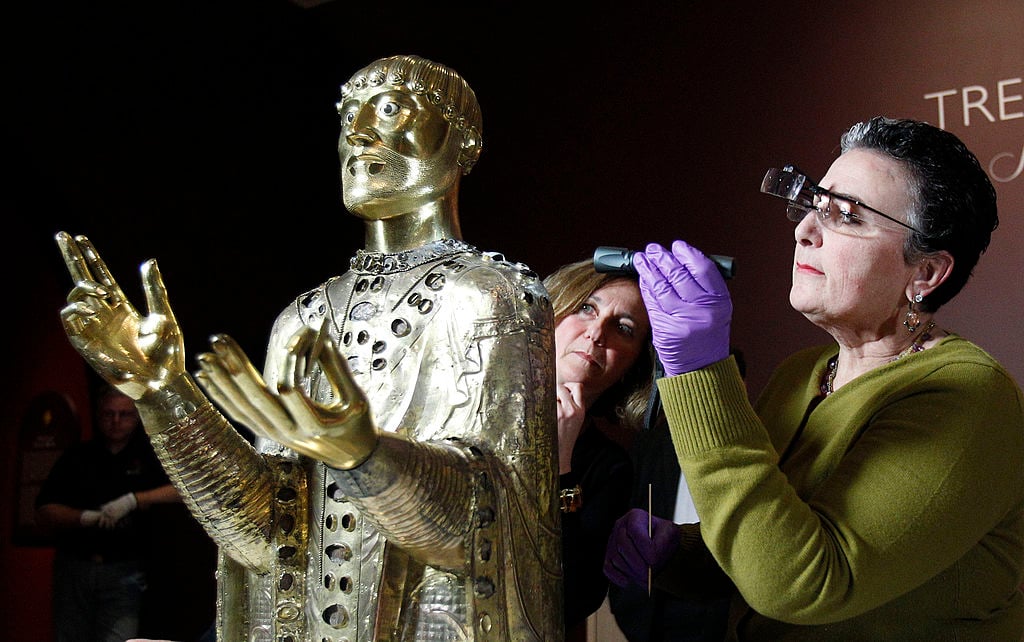
It would be difficult, if not impossible, to find a museum professional who got into the arts for the money. But even curatorial assistants have to pay rent.
A new survey conducted by the Association of Art Museum Directors (AAMD) provides hard data on the average salaries for curators, conservators, registrars, and other museum staff members—as well as which roles in this notoriously poorly paid field have seen the biggest salary bumps in recent years.
The AAMD teamed up with the consulting and analytics firm Stax, Inc., to survey 219 museums in the US, Canada, and Mexico about what they pay their employees. (Each response was completed by one representative from the museum—usually an HR coordinator.) The AAMD launched its first salary survey way back in 1918 and began collecting the data in a more formal way in 1991, but this marks the first time it has made its report free to the public.
Unsurprisingly, top administrative positions are the best compensated: The highest-paying museum gigs are director ($293,988 average annual salary), deputy director ($173,572 average salary), and chief operating officer ($172,872).
Chief curators ($143,412) and chief conservators ($118,271)—two roles that require either an advanced degree, lengthy training, or both—also fall towards the top of the salary hierarchy. The lowest-paid positions are: security guard ($33,974), education department assistant ($37,801), and curatorial assistant ($42,458).
These salaries—particularly for entry-level curators and educators—may not be enough to pay off hefty student loans, but they are higher than equivalent positions at many international institutions. Last year, for example, London’s Tate posted three jobs for assistant curators with salaries starting at £24,360 ($31,535).
Not everyone’s income is growing at the same rate, according to the survey. COOs saw the largest average annual increase: 5.5%. The survey’s authors attribute this growth to the increasing complexity of museum operations, which is driving institutions to offer more money to retain more qualified candidates. (Unlike art conservation, for example, operations management is a highly transferable skill: a COO could likely take her talent to another for-profit institution for a lot more money.)
The second fastest-growing salaried position? Curator.
Curators saw their salaries rise 4.6% per year, on average, between 2011 and 2016—in part because museums had rising demand for the position during that time. But don’t race off and enroll in a master’s degree program just yet: The number of curators is expected to grow 7% between 2014 and 2024, according to the Bureau of Labor Statistics, which is only average in terms of job growth. “Applicants should expect very strong competition for jobs,” the BLS remarks.
For their part, museum directors experienced only a 1.6% growth in median salary between 2015-2016—hardly greater than the rate of inflation. Don’t feel too sorry for them, though: Directors were also more likely than any other employee to receive vehicle and housing allowances.
Below, we’ve broken out all the job titles covered in the AAMD report, putting them in order by salary to give a sense of the museum hierarchy. The numbers represent the average (median) salary across the institutions in the survey. (When titles are broken up into As and Bs, such as with “Finance A” and “Finance B,” the As are the position within a department with more responsibility.)
- Museum Director: $233,398
- Chief Operating Officer/Administrator: $150,100
- Deputy Director: $142,994
- Chief Curator/Director of Curatorial Affairs/Curator A: $123,725
- Director of Development/Development A: $120,000
- Chief Conservator/Conservator A: $107,832
- Director of Information Systems/Chief Information Officer: $106,692
- Director of Finance/Finance A: $103,000
- Senior Curator/Curator of Special Collections Area/Curator B: $102,500
- Director, Planned Giving/Institutional Giving: $95,000
- Director of External Affairs: $94,500
- Human Resources Director: $92,830
- Senior Conservator/ Conservator B: $83,771
- Curator of Exhibitions/Curator C: $81,017
- Systems Manager/Technology Director/Director of New Media: $79,000
- Director of Education/Curator of Education/Education A: $77,030
- Facilities Director/Building Manager/Operations Manager: $75,400
- Marketing Director: $74,375
- Director of Finance/Finance B: $73,917
- Associate Curator/Curator D: $69,340
- Editor/Director of Publications: $68,688
- Engineering Manager: $67,009
- Exhibition Designer: $66,955
- Head Librarian/ Librarian A: $64,272
- Associate Conservator/ Conservator C: $61,165
- Web Manager: $60,600
- Public Relations Officer: $60,458
- Grant Manager/Institutional Giving Manager/Development B: $60,416
- Chief of Security: $60,416
- Photographer: $58,915
- Assistant Curator/Curator E: $58,052
- Registrar A: $55,973
- Associate Librarian/Librarian B: $55,703
- Graphic Designer: $55,620
- Special Events Manager: $54,368
- Assistant to Director: $53,960
- Chief Preparator/Preparator A: $53,077
- Museum Store Manager: $53,000
- Associate Registrar/Registrar B: $52,755
- Development Associate/Development C: $52,020
- Associate Educator/Educator B: $52,000
- New Media Manager: $50,000
- Associate Librarian/Librarian C: $49,728
- Associate Preparator/Preparator B: $45,127
- Volunteer Coordinator: $43,722
- Assistant Educator/Educator C: $43,000
- Assistant Registrar/Registrar C: $41,787
- Curatorial Assistant: $40,000
- Membership Assistant: $39,100
- Education Assistant: $36,025
- Museum Security Officer/Museum Security Guard: $31,213